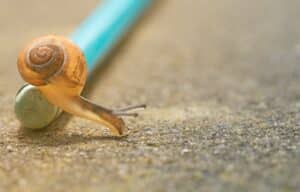Pigeons are fascinating creatures that have captured the attention of humans for centuries. They are known for their ability to fly at impressive speeds and navigate with precision. Understanding the speed of pigeons is important for various reasons, including their use in racing and their historical significance in postal services. In this article, we will explore the different aspects of pigeon speed, including how it is measured, the fastest pigeon breeds, the impact of wind on their speed, and their speed in comparison to other animals.
The Speed of a Pigeon: An Introduction
Pigeons are known for their remarkable speed in flight. They have been observed flying at speeds of up to 60 miles per hour (97 kilometers per hour). This makes them one of the fastest birds in the world. In comparison to other birds, pigeons are known to be faster than ducks and geese but slower than falcons and hawks.
The speed of pigeons is crucial for their survival and daily activities. They rely on their speed to escape from predators, find food, and navigate through their environment. Pigeons have strong wing muscles that allow them to generate a significant amount of power during flight. Their streamlined bodies and aerodynamic feathers also contribute to their ability to fly at high speeds.
How Do We Measure the Speed of Pigeons?
Measuring the speed of pigeons has evolved over time with advancements in technology. In the past, pigeon racing enthusiasts would use stopwatches to time the birds as they flew from one location to another. Today, electronic timing systems are commonly used, which provide more accurate measurements.
These electronic timing systems consist of a band or chip that is attached to the pigeon’s leg. As the bird crosses a designated finish line, a sensor records the time it takes for the bird to complete the race. This data is then used to calculate the bird’s average speed.
The accuracy of these measurements has greatly improved with the use of electronic timing systems. However, factors such as wind conditions and the distance of the race can still affect the overall speed of the pigeons.
The Fastest Pigeon Breeds in the World
There are several pigeon breeds that are known for their exceptional speed. The most famous of these breeds is the Racing Homer, which is specifically bred for its speed and endurance in racing competitions. Other fast pigeon breeds include the Sion, the Tippler, and the Birmingham Roller.
The speeds of these pigeon breeds can vary, but on average, they can fly at speeds between 50 to 60 miles per hour (80 to 97 kilometers per hour). The Racing Homer, in particular, has been known to reach speeds of up to 90 miles per hour (145 kilometers per hour) during races.
Several factors contribute to the speed of these pigeon breeds, including their genetics, physical conditioning, and training. Pigeon fanciers carefully select breeding pairs to produce offspring with desirable traits such as speed and endurance.
How Fast Can Racing Pigeons Fly?
Racing pigeons are a specialized breed that is trained and conditioned for competitive racing events. These events involve releasing the pigeons from a specific location and timing how long it takes for them to return to their home loft.
On average, racing pigeons can fly at speeds between 40 to 50 miles per hour (64 to 80 kilometers per hour) during races. However, some exceptional birds have been known to achieve even higher speeds. The record for the fastest racing pigeon was set in Belgium in 1931 when a bird named “Bolt” flew at an astonishing speed of 92 miles per hour (148 kilometers per hour).
The speed of racing pigeons is influenced by various factors, including weather conditions, wind direction, and the distance of the race. Pigeons are known to be affected by headwinds, which can slow them down, while tailwinds can help them achieve higher speeds.
The Speed of Racing Pigeons: A Comparison
When comparing the speed of racing pigeons to other birds, they are considered to be relatively fast. Falcons and hawks are known to be the fastest birds in terms of speed, with some species reaching speeds of over 200 miles per hour (322 kilometers per hour) during hunting dives.
In comparison to other animals, racing pigeons are faster than most land animals but slower than some marine animals. For example, cheetahs are known to be the fastest land animals, reaching speeds of up to 70 miles per hour (113 kilometers per hour). Dolphins, on the other hand, can swim at speeds of up to 25 miles per hour (40 kilometers per hour).
The differences in speed between different animals can be attributed to their physical adaptations and the environments in which they live. Birds have evolved to have lightweight bodies and powerful wings that allow them to achieve high speeds in flight.
The Influence of Wind on the Speed of Pigeons
Wind conditions play a significant role in the speed of pigeons during flight. Headwinds, which blow against the direction of flight, can slow down pigeons and make their journey more challenging. Tailwinds, on the other hand, can provide a boost and help pigeons achieve higher speeds.
Pigeons have developed strategies to navigate through wind and optimize their flight. They often fly in flocks or formations, which allows them to take advantage of the aerodynamic benefits of flying in a group. By flying in a V-formation, pigeons can reduce wind resistance and conserve energy.
When flying against strong headwinds, pigeons may employ a technique called “tacking” or “zigzagging.” This involves flying at an angle to the wind and then changing direction periodically to minimize the impact of the headwind. By using this strategy, pigeons can maintain a relatively constant speed and make progress towards their destination.
How Far Can Pigeons Fly at Maximum Speed?
Pigeons are capable of covering impressive distances at their maximum speed. On average, racing pigeons can fly for distances of up to 500 miles (805 kilometers) in a single race. However, some races can be even longer, with pigeons flying over 1,000 miles (1,609 kilometers) to reach their destination.
The distance that pigeons can cover at maximum speed is influenced by various factors, including their physical condition, training, and weather conditions. Pigeon fanciers carefully prepare their birds for long-distance races by gradually increasing the distances they fly during training.
In comparison to other birds, pigeons are known for their endurance and ability to fly long distances without rest. This makes them well-suited for tasks such as homing and message delivery.
The Speed of Pigeons in Comparison with Other Animals
When comparing the speed of pigeons to other animals, they are considered to be relatively fast. However, there are several animals that can outpace them in terms of speed.
Cheetahs, as mentioned earlier, are known to be the fastest land animals, reaching speeds of up to 70 miles per hour (113 kilometers per hour). Falcons and hawks are the fastest birds, with some species reaching speeds of over 200 miles per hour (322 kilometers per hour) during hunting dives.
In terms of marine animals, dolphins are known for their agility and speed in the water. They can swim at speeds of up to 25 miles per hour (40 kilometers per hour). Some species of fish, such as sailfish and marlin, are also known for their impressive swimming speeds.
The differences in speed between different animals can be attributed to their physical adaptations and the environments in which they live. Each animal has evolved to excel in its specific habitat and fulfill its ecological niche.
The Speed of Pigeons in History: From Post Coaches to Modern Postal Services
Pigeons have played a significant role in human history, particularly in the field of communication. In ancient times, pigeons were used as messengers to deliver important messages over long distances. They were trained to fly back to their home loft, carrying small scrolls or capsules with messages attached to their legs.
During the 19th century, pigeons were used as a means of communication in various parts of the world. In Europe, pigeon post services were established, allowing people to send messages quickly and efficiently. Pigeon post was particularly popular during times of war when traditional communication methods were disrupted.
With the advent of modern technology, the use of pigeons as messengers has declined. However, they still play a role in some remote areas where communication infrastructure is limited. Pigeon racing has also become a popular sport and hobby, allowing enthusiasts to showcase the speed and endurance of their birds.
How Can Pigeons Fly So Fast and Yet Navigate So Precisely?
Pigeons have a remarkable ability to fly at high speeds while navigating with precision. This is due to their unique navigation system, which relies on a combination of visual cues, magnetic fields, and olfactory senses.
Pigeons have excellent eyesight and can see details from great distances. They use landmarks such as mountains, rivers, and buildings to orient themselves and navigate through their environment. They also have a keen sense of smell, which allows them to detect familiar scents and find their way back to their home loft.
In addition to visual and olfactory cues, pigeons are also sensitive to Earth’s magnetic fields. They have tiny magnetic particles in their beaks that act as a compass, helping them determine their direction. This ability to sense magnetic fields is believed to be one of the key factors that enable pigeons to navigate accurately over long distances.
When flying at high speeds, pigeons rely on their agility and maneuverability to navigate through obstacles and maintain their course. Their powerful wings and streamlined bodies allow them to make quick turns and adjustments in flight, ensuring that they can fly at high speeds while maintaining control.
Understanding the speed of pigeons is important for various reasons, including their use in racing and their historical significance in postal services. Pigeons are known for their remarkable speed in flight, with some breeds capable of reaching speeds of up to 60 miles per hour (97 kilometers per hour). Measuring the speed of pigeons has evolved over time with advancements in technology, and today, electronic timing systems are commonly used to provide more accurate measurements.
The fastest pigeon breeds in the world include the Racing Homer, the Sion, the Tippler, and the Birmingham Roller. Racing pigeons can fly at speeds between 40 to 50 miles per hour (64 to 80 kilometers per hour) during races, with some exceptional birds achieving even higher speeds. Wind conditions play a significant role in the speed of pigeons, with headwinds slowing them down and tailwinds providing a boost.
Pigeons are relatively fast compared to other animals but are slower than falcons, hawks, cheetahs, and dolphins. Their ability to fly at high speeds while navigating with precision is attributed to their unique navigation system, which relies on visual cues, magnetic fields, and olfactory senses. Pigeons have played a significant role in human history, particularly in communication, and continue to captivate our fascination with their impressive speed and agility.
Bent u geïnteresseerd in de snelheid van duiven? Dan is het artikel “Hoe snel kan een duif vliegen?” op Dierensport.nl iets voor u. In dit artikel wordt uitgelegd hoe duiven in staat zijn om hoge snelheden te bereiken tijdens het vliegen. Het geeft ook inzicht in de factoren die van invloed zijn op de vliegsnelheid van duiven, zoals hun fysieke kenmerken en omgevingsomstandigheden. Klik hier om het artikel te lezen: https://dierensport.nl/duivensport/
FAQs
Hoe snel kan een duif vliegen?
Een duif kan gemiddeld tussen de 50 en 80 kilometer per uur vliegen.
Hoe ver kan een duif vliegen?
Een duif kan afstanden tot wel 1000 kilometer afleggen.
Hoe lang kan een duif vliegen?
Een duif kan tot wel 12 uur achter elkaar vliegen.
Hoe navigeren duiven tijdens het vliegen?
Duiven navigeren tijdens het vliegen op basis van hun zicht, geur en het aardmagnetisch veld.
Zijn er verschillen in snelheid tussen mannelijke en vrouwelijke duiven?
Er zijn geen significante verschillen in snelheid tussen mannelijke en vrouwelijke duiven.
Zijn er verschillen in snelheid tussen verschillende soorten duiven?
Er zijn verschillen in snelheid tussen verschillende soorten duiven. Zo zijn postduiven bijvoorbeeld sneller dan stadsduiven.









